Candaba
Candaba, officially the Municipality of Candaba (Kapampangan: Balen ning Candaba; formerly Candawe), is a 1st class municipality in the province of Pampanga, Philippines. According to the 2015 census, it has a population of 111,586 people. [3]
Candaba | |
|---|---|
| Municipality of Candaba | |
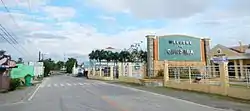 Downtown area | |
 Seal | |
| Etymology: Vizal Santo Cristo Candaba | |
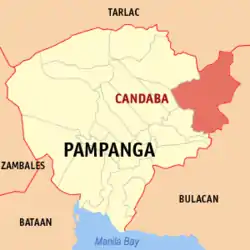 Map of Pampanga with Candaba highlighted | |
OpenStreetMap 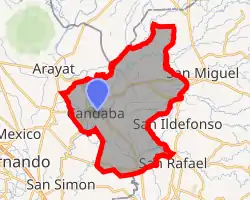
| |
.svg.png.webp) Candaba Location within the Philippines | |
| Coordinates: 15°05′36″N 120°49′42″E | |
| Country | |
| Region | Central Luzon (Region III) |
| Province | Pampanga |
| District | 4th District |
| Barangays | 33 (see Barangays) |
| Government | |
| • Type | Sangguniang Bayan |
| • Mayor | Rene Maglanque |
| • Vice Mayor | Michael Dan V. Sagum |
| • Representative | Juan Pablo P. Bondoc |
| • Electorate | 72,535 voters (2019) |
| Area | |
| • Total | 176.40 km2 (68.11 sq mi) |
| Elevation | 28 m (92 ft) |
| Population | |
| • Total | 111,586 |
| • Density | 630/km2 (1,600/sq mi) |
| • Households | 22,428 |
| Economy | |
| • Income class | 1st municipal income class |
| • Poverty incidence | 12.48% (2015)[4] |
| • Revenue | ₱196,026,101.73 (2016) |
| Time zone | UTC+8 (PST) |
| ZIP code | 2013 |
| PSGC | |
| IDD : area code | +63 (0)45 |
| Climate type | tropical monsoon climate |
| Native languages | Kapampangan Tagalog |
| Website | www |
Geography
Candaba represents the lowest point in Central Luzon Region of Luzon Island. The neighboring municipality of San Miguel (San Miguel de Mayumo) in Bulacan province used to be part of Candaba until San Miguel became a municipality itself.
Candaba's municipal boundaries are: Municipality of Arayat, Pampanga, and Municipality of Cabiao, Nueva Ecija, to the north; Municipality of San Miguel, Bulacan, and Municipality of San Ildefonso, Bulacan, to the east; Municipality of Baliuag, Bulacan, to the south; Municipality of San Luis, Pampanga, and Municipality of Santa Ana, Pampanga, to the west.
Candaba is also divided to 3 regions, the Tagalog Region comprising the southern part of Candaba which was a boundary between it and Baliuag and San Ildefonso, next is the Poblacion Region to the west which boundaries with Sta Ana, and next is the Kapampangan Region to the east which boundaries San Miguel.
Barangays
Candaba is politically subdivided into 33 barangays.
- Bahay Pare
- Bambang
- Barangca
- Barit
- Buas (Poblacion)
- Cuayang Bugtong
- Dalayap
- Dulong Ilog
- Gulap
- Lanang
- Lourdes
- Magumbali
- Mandasig
- Mandili
- Mangga
- Mapaniqui
- Paligui
- Pangclara
- Pansinao
- Paralaya (Poblacion)
- Pasig
- Pescadores (Poblacion)
- Pulong Gubat
- Pulong Palazan
- Salapungan
- San Agustin (Poblacion)
- Santo Rosario
- Tagulod
- Talang
- Tenejero
- Vizal San Pablo
- Vizal Santo Cristo
- Vizal Santo Niño
Climate
Like rest of the area in Central Luzon, there are two seasons in the area, the wet season and dry season. The wet season occurs during the months of May to October, and the dry season the rest of the year.
| Climate data for Candaba, Pampanga | |||||||||||||
|---|---|---|---|---|---|---|---|---|---|---|---|---|---|
| Month | Jan | Feb | Mar | Apr | May | Jun | Jul | Aug | Sep | Oct | Nov | Dec | Year |
| Average high °C (°F) | 28 (82) |
29 (84) |
31 (88) |
33 (91) |
32 (90) |
31 (88) |
30 (86) |
29 (84) |
29 (84) |
30 (86) |
30 (86) |
28 (82) |
30 (86) |
| Average low °C (°F) | 20 (68) |
20 (68) |
21 (70) |
23 (73) |
24 (75) |
24 (75) |
24 (75) |
24 (75) |
24 (75) |
23 (73) |
22 (72) |
21 (70) |
23 (72) |
| Average precipitation mm (inches) | 6 (0.2) |
4 (0.2) |
6 (0.2) |
17 (0.7) |
82 (3.2) |
122 (4.8) |
151 (5.9) |
123 (4.8) |
124 (4.9) |
99 (3.9) |
37 (1.5) |
21 (0.8) |
792 (31.1) |
| Average rainy days | 3.3 | 2.5 | 3.6 | 6.6 | 17.7 | 22.2 | 25.2 | 23.7 | 23.2 | 17.9 | 9.2 | 5.2 | 160.3 |
| Source: Meteoblue (Use with caution: this is modeled/calculated data, not measured locally.) [5] | |||||||||||||
Demographics
|
| ||||||||||||||||||||||||||||||||||||||||||||||||
| Source: Philippine Statistics Authority [3] [6] [7][8] | |||||||||||||||||||||||||||||||||||||||||||||||||
In the 2015 census, the population of Candaba, Pampanga, was 111,586 people, [3] with a density of 630 inhabitants per square kilometre or 1,600 inhabitants per square mile.
Religion
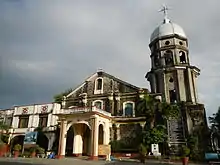
Roman Catholic 60%, Members Church of God International 3.5%, Iglesia ni Cristo 3%, Evangelicals 32%, others (includes Islam, Buddhism and other religions) 1.5%. The Saint Andrew church serves as one of the Roman Catholic parish churches inside the municipality.
The most popular religious site in Candaba is in the barangay "Pulong Gubat". It pulls many pilgrims who believe that Nuestra Señor dela Pacencia will cure their illness or grant their wishes.
Local government
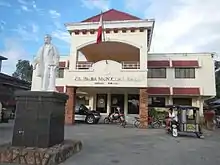
The following are the duly elected officials of this town for the term 2019-2022:
| Position | Name |
|---|---|
| Mayor | Rene E. Maglanque (PDP–Laban) |
| Vice Mayor | Michael Dan V. Sagum (PDP–Laban) |
| Councilors | Nelson Alonzo (PDP–Laban)
Amy Rose Baylon (Independent) Joey Buco (Independent) Dan Gallarado (Independent) Carol Foz (Independent) Jun Gatus (Independent) Ate Thelma Macapagal (KAMBILAN) Siso Maglanque (PDP–Laban) Doña Salac (PDP–Laban) Maine Santiago (PDP–Laban) |
Economy
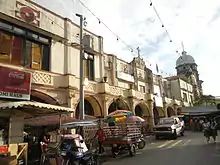
The Candaba Swamp (Pinac, Pinak) absorbs most of the flood waters that flow from the western slopes of the Sierra Madre Mountain Range. During the rainy season, the Pampanga River overflows and the swamp is submerged. But it is relatively dry during the dry Season, hence making the land suitable for a variety agricultural production.
Candaba is noted for its production watermelon, that are sold worldwide. The swamps are communal fishing grounds encompassing some 430 km2 of highly arable farmlands. Candaba swamps are very fertile due to its sustained deposits of humus and decaying plant residues. Migrant wild ducks and various wildlife bird from Siberia, New Zealand, Mongolia and other parts of Asia use Candaba as their yearly sanctuary.
Infrastructure
- Drainage System
Candaba-San Miguel road is known for being flooded when a typhoon hits Candaba. The drainage system or rip-rap, which is a part of Mayor Jerry Pelayo's road cementing project, was built on both sides of every cemented roads made so the rainwater from other parts of Pampanga will just flow on it and not on the road.
Transportation
Public transport is mainly done by means of jeepneys and tricycles. Jeepneys have their routes as an itinerary route for various places. Candaba-San Miguel road or pinak was fully cemented by 2014.
Telecommunication facilities
Candabas telecommunication facilities and telephone services are provided by the Philippine Long Distance Telephone Company (PLDT), PSE.DGTL, Datelcom, Evangelista Telephone Company and the Pampanga Telecom Company.
Water and power utilities
- Waterworks
Candaba will soon have modern waterworks, following the start of a 24 million Peso water supply development project of the Candaba Water District (CWD) with the financial and technical assistance of the Local Water Utilities Administration (LWUA). Other means to get drinking water are water wells.
- Electric power
The municipality receives it electric power in from the Pampanga 1 Electric Cooperative (PELCO 1) and from Manila Electric Company (MERALCO).[9][10]
| PSGC | Barangay | Electric Utility | Acronym |
|---|---|---|---|
| 35405001 | Bahay Pare | Manila Electric Company | MERALCO |
| 35405002 | Bambang | Pampanga 1 Electric Cooperative | PELCO 1 |
| 35405003 | Barangca | Manila Electric Company | MERALCO |
| 35405004 | Barit | Pampanga 1 Electric Cooperative | PELCO 1 |
| 35405005 | Buas (Poblacion) | Pampanga 1 Electric Cooperative | PELCO 1 |
| 35405008 | Cuayang Bugtong | Pampanga 1 Electric Cooperative | PELCO 1 |
| 35405009 | Dalayap | Pampanga 1 Electric Cooperative | PELCO 1 |
| 35405010 | Dulong Ilog | Manila Electric Company | MERALCO |
| 35405011 | Gulap | Pampanga 1 Electric Cooperative | PELCO 1 |
| 35405012 | Lanang | Pampanga 1 Electric Cooperative | PELCO 1 |
| 35405013 | Lourdes | Pampanga 1 Electric Cooperative | PELCO 1 |
| 35405014 | Magumbali | Manila Electric Company | MERALCO |
| 35405015 | Mandasig | Pampanga 1 Electric Cooperative | PELCO 1 |
| 35405016 | Mandili | Manila Electric Company | MERALCO |
| 35405017 | Mangga | Pampanga 1 Electric Cooperative | PELCO 1 |
| 35405018 | Mapaniqui | Manila Electric Company | MERALCO |
| 35405020 | Paligui | Manila Electric Company | MERALCO |
| 35405021 | Pangclara | Manila Electric Company | MERALCO |
| 35405022 | Pansinao | Pampanga 1 Electric Cooperative | PELCO 1 |
| 35405023 | Paralaya (Poblacion) | Pampanga 1 Electric Cooperative | PELCO 1 |
| 35405024 | Pasig | Pampanga 1 Electric Cooperative | PELCO 1 |
| 35405025 | Pescadores (Poblacion) | Pampanga 1 Electric Cooperative | PELCO 1 |
| 35405026 | Pulong Gubat | Manila Electric Company | MERALCO |
| 35405027 | Pulong Palazan | Manila Electric Company | MERALCO |
| 35405028 | Salapungan | Manila Electric Company | MERALCO |
| 35405029 | San Agustin (Poblacion) | Pampanga 1 Electric Cooperative | PELCO 1 |
| 35405031 | Santo Rosario | Pampanga 1 Electric Cooperative | PELCO 1 |
| 35405032 | Tagulod | Pampanga 1 Electric Cooperative | PELCO 1 |
| 35405033 | Talang | Pampanga 1 Electric Cooperative | PELCO 1 |
| 35405034 | Tenejero | Manila Electric Company | MERALCO |
| 35405035 | Vizal San Pablo | Manila Electric Company | MERALCO |
| 35405036 | Vizal Santo Cristo | Manila Electric Company | MERALCO |
| 35405037 | Vizal Santo Niño | Manila Electric Company | MERALCO |
Bird sanctuary
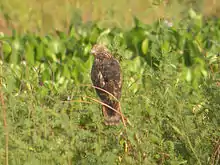
On January 2008, a Philippine record of 17,000 birds (in the 24-hour count) visited the 32,000-hectare Candaba Swamp, sanctuary for migratory birds. Michael Lu, president of the Wild Bird Club of the Philippines (WBCP), stated that 80 species of migratory birds were sighted at the 100-hectare fishpond of Mayor Jerry Pelayo in Barangay Doña Simang and in Barangay Paralaya. The rare birds spotted were: the Shrenck’s bittern, great bittern, gadwall, coot, Philippine mallard or ducks, and Eurasian spoonbill (Platalea leucorodia). Robert S. Kennedy’s book A Guide to the Birds of the Philippines lists endemic and migratory birds which visit the Philippines. Pelayo organized the Ibon-Ebon Festival (“birds and eggs”) on February 1–2. The WBCP recorded three rare species in Candaba swamp: the purple swamphen (Porphyrio porphyrio), Chinese pond heron (Ardeola bacchus) and the black-crowned night heron (Nycticorax nycticorax).[11]
References
- Municipality of Candaba | (DILG)
- "Province: Pampanga". PSGC Interactive. Quezon City, Philippines: Philippine Statistics Authority. Retrieved 12 November 2016.
- Census of Population (2015). "Region III (Central Luzon)". Total Population by Province, City, Municipality and Barangay. PSA. Retrieved 20 June 2016.
- "PSA releases the 2015 Municipal and City Level Poverty Estimates". Quezon City, Philippines. Retrieved 1 January 2020.
- "Candaba: Average Temperatures and Rainfall". Meteoblue. Retrieved 5 May 2020.
- Census of Population and Housing (2010). "Region III (Central Luzon)". Total Population by Province, City, Municipality and Barangay. NSO. Retrieved 29 June 2016.
- Censuses of Population (1903–2007). "Region III (Central Luzon)". Table 1. Population Enumerated in Various Censuses by Province/Highly Urbanized City: 1903 to 2007. NSO.
- "Province of Pampanga". Municipality Population Data. Local Water Utilities Administration Research Division. Retrieved 17 December 2016.
- http://www.lawphil.net/statutes/repacts/ra2003/ra_9209_2003.html
- http://www.kuryente.org.ph/electric-company/municipalities/27
- "17,000 birds sighted in Candaba swamp". Philippine Daily Inquirer. Archived from the original on 2008-02-01. Retrieved 2008-01-14.
Bibliography
- Gatbonton, Manuel, Ing Candawe, excerpts, 1933.
- Henson, Mariano A., Pampanga and Its Towns (AD 1300-1965), Angeles: 1965.
- Licuanan, Virginia Benitez and Jose Llavador Mira, The Philippines Under Spain: A Compilation and Translation of Original Documents, Quezon City: 1993.
- Pangilinan, Michael Raymon M. (Siuala ding Meangubie), Five Thousand Years of Antiquity: A Timeline of Candaba History, Kapampangan Magazine, ed. by Elmer G. Cato, ISSN 1656-5592, Year 2004, Issue XV, pp. 11–12.
- Pangilinan, Michael Raymon M. (Siuala ding Meangubie), Candaba: Timelessly Mystical, Kapampangan Magazine, ed. by Elmer G. Cato, ISSN 1656-5592, Year 2004, Issue XV, pp. 16–17.
- San Agustin, Gaspar de, Conquistas de las Islas Filipinas; 1565–1615, 1st Bilingual Edition, Intramuros: 1998.
- The Historical Data Papers, Candaba, Bureau of Public Schools, 1953
- The Contemporary Chinese Dictionary (Chinese-English Edition), Foreign Language Teaching and Research Press, Beijing 2002.
External links
| Wikimedia Commons has media related to Candaba, Pampanga. |